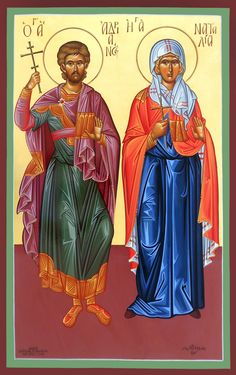Saints Aurelius and Natalia and St Titus Brandsma

Martyrs. These were two members of a group of five Christians martyred at Cordoba in Spain, by the Muslim Emir Abd ar-Rahman II in about 852. Aurelius was the son of a Muslim man and a Spanish woman who was a secret Christian. Natalia also came from a Muslim and Christian family. Aurelius had a relative, Felix who became Muslim for a time but then returned to his Christian faith and married a Christian wife, Liliosa.
All four openly professed their faith and the women went out with their faces unveiled. They were arrested for apostacy and all beheaded, together with a monk, named George who had openly preached against the Muslim religion.
and Saint Titus Brandsma
Martyr. Dutch Carmelite friar, Catholic priest, journalist and professor of philosophy.
Born on 23 February 1881, in Friesland, his parents Anno Sjoerd Brandsma and Tjitsje Postma were dairy farmers. They were devout Catholics in what was a very Calvinist region. With the exception of one daughter, all of their children (three daughters and two sons) entered religious orders. Brandsma joined the Carmelites in 1898, taking the religious name Titus in honour of his father. He was ordained a priest in 1905.
Brandsma was awarded a doctorate of philosophy from Pontifical Gregorian University in Rome in 1909. From 1909 to 1923 he lived in Oss and worked as a writer and teacher. From 1916 on, he initiated and led a project to translate the works of Teresa of Ávila into Dutch. In 1919 he founded and for two years acted as head of a secondary school in Oss-the present day Titus Brandsma Lyceum.
In 1921, Brandsma worked to resolve a controversy concerning Belgian artist Albert Servaes' depiction of the Stations of the Cross. From this came his series of meditations on each of the 14 stations.
One of the founders of the Catholic University of Nijmegen (now Radboud University), Brandsma became a professor of philosophy and the history of mysticism at the school in 1923. He later served as rector magnificus (1932-33).
He was noted for his constant availability to everyone, rather than for his scholarly work as a professor. Brandsma also worked as a journalist and was the ecclesiastical adviser to Catholic journalists by 1935. He stayed at the friary of Our Lady of Mount Carmel Kinsale, where he practiced English. That same year he traveled for a lecture tour of the United States and Canada, speaking at various institutions of his order.
On the occasion of his visit to a Carmelite seminary in Niagara Falls, Ontario, Brandsma wrote of the falls that "I not only see the riches of the nature of the water, its immeasurable potentiality; I see God working in the work of his hands and the manifestation of his love."
After the invasion of the Netherlands by the Third Reich in May 1940, Brandsma's long-term fight against the spread of Nazi ideology and for educational and press freedom brought him to the attention of the Nazis.
In January 1942, he undertook to deliver by hand a letter from the Conference of Dutch Bishops to the editors of Catholic newspapers, in which the bishops ordered them not to print official Nazi documents, as was required under a new law by the German occupiers. He had visited fourteen editors before being arrested on 19 January at Boxmeer Carmelite Priory.
Accused of being an ally of communism, he was dubbed by the Nazis as "the Dangerous Little Friar". After being held prisoner in Scheveningen, Amersfoort, and Cleves, Brandsma was transferred to the Dachau concentration camp, arriving there on 19 June 1942. His health quickly gave way, and he was transferred to the camp hospital. He died on 26 July 1942, from a lethal injection administered by a nurse of the Allgemeine SS, as part of their program of medical experimentation on the prisoners.
In 1955 a group of survivors of Dachau wrote to the Pope asking for his beatification. Clergy of other faiths as well as Catholic priests were among the signatories to that letter and recorded their Dachau inmate number next to their signature. Later they gave moving testimony of the effect Titus had on them as his cause progressed. Titus was a pioneer of ecumenism. He was an active supporter of the Apostolate of Reunification of the Eastern Churches during the 1930s and also established close links with Protestant pastors. In 1963, Cardinal Montini (later Paul VI), and Archbishop Josyp Slipyj of the Ukrainian Greek Church, later made a Cardinal by Paul V1, added their names to those petitioning the introduction of Titus' cause.
He was beatified by the Catholic Church in November 1985 as a martyr of the faith and canonized as a saint on 15 May 2022 by Pope Francis, along with others, including Blessed Charles de Foucauld.
For more information see: https://carmelite.org/spirituality/titus-brandsma/












